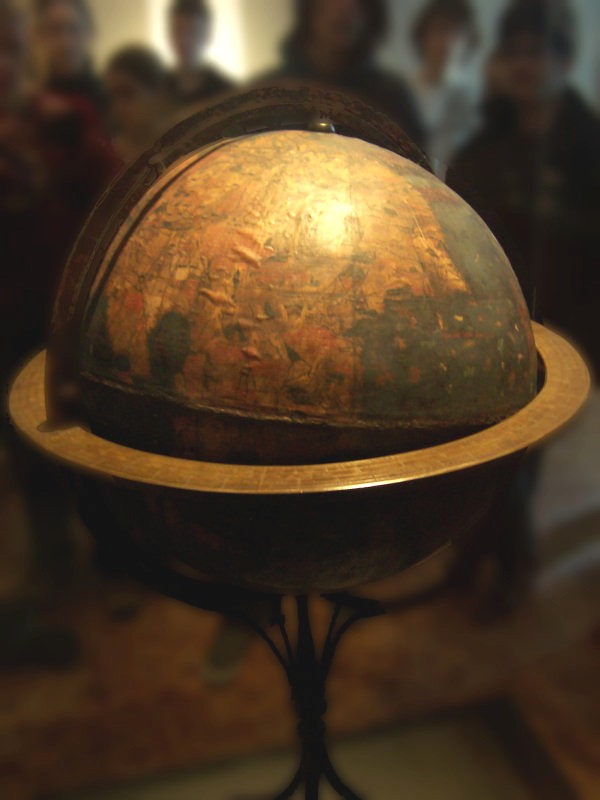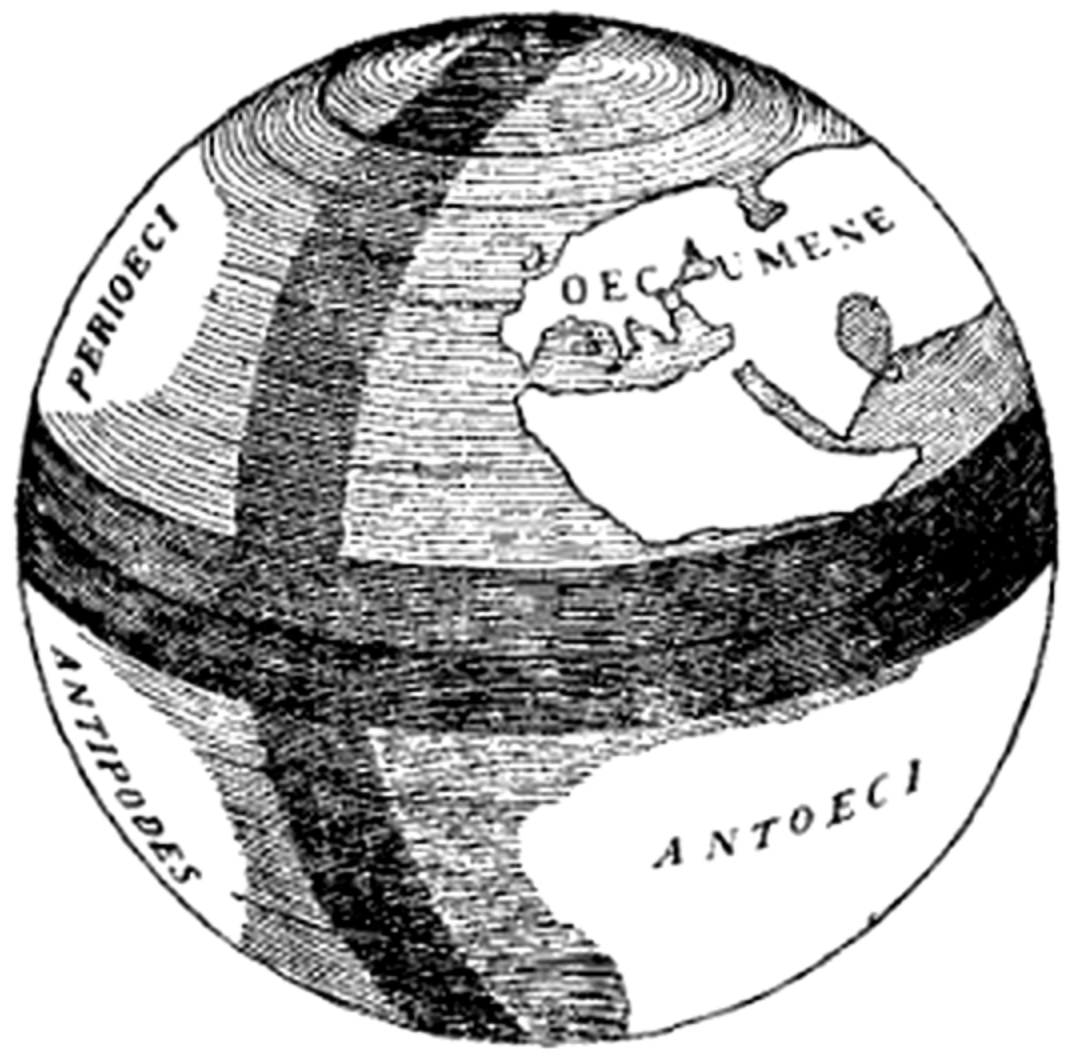|
Behaim's Globe
__NOTOC__ The (; ) is a terrestrial globe produced by Martin Behaim from 1490–1492. The Erdapfel is the oldest surviving terrestrial globe. It is constructed of a laminated linen ball in two halves, reinforced with wood and overlaid with a map painted on gores by Georg Glockendon. The map was drawn on paper, which was pasted on a layer of parchment around the globe. The Americas are not included, as Columbus returned to Spain no sooner than March 1493. The globe shows an enlarged Eurasian continent and an empty ocean between Europe and Asia. The mythical Saint Brendan's Island is included. Cipangu ( Japan) is oversized and well south of its true position; Martellus's map is followed in developing an enormous phantom peninsula east of the Golden Chersonese (Malaysia). The idea to call the globe "apple" may be related to the Reichsapfel ("Imperial Apple", Globus cruciger) which was also kept in Nuremberg along with the Imperial Regalia (Reichskleinodien). The name is not ... [...More Info...] [...Related Items...] OR: [Wikipedia] [Google] [Baidu] |
Globus Cruciger
The ''globus cruciger'' ( for, , Latin, cross-bearing orb), also known as "the orb and cross", is an orb surmounted by a cross. It has been a Christian symbol of authority since the Middle Ages, used on coins, in iconography, and with a sceptre as royal regalia. The cross represents Christ's dominion over the orb of the world, literally held in the hand of an earthly ruler. In the iconography of Western art, when Christ himself holds the globe, he is called ''Salvator Mundi'' (Latin for 'Saviour of the World'). For instance, the 16th-century Infant Jesus of Prague statue holds a ''globus cruciger'' in this manner. History Holding the world in one's hand, or, more ominously, under one's foot, has been a symbol since antiquity. To citizens of the Roman Empire, the plain spherical globe held by the god Jupiter represented the world or the universe, as the dominion held by the Emperor. A 2nd-century coin from the reign of Emperor Hadrian shows the Roman goddess Salus with ... [...More Info...] [...Related Items...] OR: [Wikipedia] [Google] [Baidu] |
Collections Of The Germanisches Nationalmuseum
Collection or Collections may refer to: * Cash collection, the function of an accounts receivable department * Collection (church), money donated by the congregation during a church service * Collection agency, agency to collect cash * Collections management (museum) ** Collection (museum), objects in a particular field forms the core basis for the museum ** Fonds in archives ** Private collection, sometimes just called "collection" * Collection (Oxford colleges), a beginning-of-term exam or Principal's Collections * Collection (horse), a horse carrying more weight on his hindquarters than his forehand * Collection (racehorse), an Irish-bred, Hong Kong based Thoroughbred racehorse * Collection (publishing), a gathering of books under the same title at the same publisher * Scientific collection, any systematic collection of objects for scientific study Collection may also refer to: Computing * Collection (abstract data type), the abstract concept of collections in computer scienc ... [...More Info...] [...Related Items...] OR: [Wikipedia] [Google] [Baidu] |
Historic Maps Of The World
History (derived ) is the systematic study and the documentation of the human activity. The time period of event before the invention of writing systems is considered prehistory. "History" is an umbrella term comprising past events as well as the memory, discovery, collection, organization, presentation, and interpretation of these events. Historians seek knowledge of the past using historical sources such as written documents, oral accounts, art and material artifacts, and ecological markers. History is not complete and still has debatable mysteries. History is also an academic discipline which uses narrative to describe, examine, question, and analyze past events, and investigate their patterns of cause and effect. Historians often debate which narrative best explains an event, as well as the significance of different causes and effects. Historians also debate the nature of history as an end in itself, as well as its usefulness to give perspective on the problems of the p ... [...More Info...] [...Related Items...] OR: [Wikipedia] [Google] [Baidu] |
Ostrich Egg Globe
The Ostrich Egg Globe is a hollow terrestrial globe made from the conjoined lower halves of two ostrich eggs. The owner of the globe claims that it was made in the early 16th century and is the first globe to depict the New World (with North America only shown as small islands). The carvings on the globe are similar to those on the Hunt–Lenox Globe, a red copper cast. Provenance The globe was offered for sale in 2012 at the London Map Fair held at the Royal Geographical Society. Its similarity to the Lenox Globe was confirmed by the former president of the Coronelli Society, Professor Rudolf Schmidt, and confirmed by art expert Archduke Dr. Géza von Habsburg in 2013. The owner of the globe, Stefaan Missinne, has written a book that argues that the globe was made by Leonardo da Vinci, citing writings by Leonardo indicating a similar approach to making globe gores. Cartographer Wouter Bracke states that Missine's book should be considered "a report on the author's resea ... [...More Info...] [...Related Items...] OR: [Wikipedia] [Google] [Baidu] |
Lenox Globe
Lenox may refer to: Places in the United States * Lenox, Alabama * Lenox, Georgia * Lenox, Iowa ** Lenox College, former college in Hopkinton, Iowa * Lenox, Kentucky * Lenox, Massachusetts, a New England town ** Lenox (CDP), Massachusetts, the main village in the town * Lenox, Missouri * Lenox, New York ** Lenox Avenue, in Harlem, New York City * Lenox, Ohio, original name for North Olmsted, Ohio * Lenox, Oklahoma * Lenox, Tennessee * Lenox, Memphis, Tennessee, a neighborhood * New Lenox, Illinois * Lenox Township (other) People First name * Lenox Baker (1902–1995), American orthopedic surgeon and athletic trainer * Lenox Hewitt (born 1917), retired senior Australian public servant * Lenox Paul (born 1958), English bobsledder Surname * Adriane Lenox, American actress * Robert Lenox (1759–1839), a Scottish-American merchant who served as the 15th president of the Saint Andrew's Society of the State of New York * James Lenox (1800–1880), an American biblio ... [...More Info...] [...Related Items...] OR: [Wikipedia] [Google] [Baidu] |
Early World Maps
The earliest known world maps date to classical antiquity, the oldest examples of the 6th to 5th centuries BCE still based on the flat Earth paradigm. World maps assuming a spherical Earth first appear in the Hellenistic period. The developments of Greek geography during this time, notably by Eratosthenes and Posidonius culminated in the Roman era, with Ptolemy's world map (2nd century CE), which would remain authoritative throughout the Middle Ages. Since Ptolemy, knowledge of the approximate size of the Earth allowed cartographers to estimate the extent of their geographical knowledge, and to indicate parts of the planet known to exist but not yet explored as ''terra incognita''. With the Age of Discovery, during the 15th to 18th centuries, world maps became increasingly accurate; exploration of Antarctica, Australia, and the interior of Africa by western mapmakers was left to the 19th and early 20th century. Antiquity Bronze Age “Saint-Bélec slab” The Saint-Bélec sla ... [...More Info...] [...Related Items...] OR: [Wikipedia] [Google] [Baidu] |
Farnese Atlas
The Farnese Atlas is a 2nd-century AD Roman marble sculpture of Atlas holding up a celestial globe. Probably a copy of an earlier work of the Hellenistic period, it is the oldest extant statue of Atlas, a Titan of Greek mythology who is represented in earlier Greek vase painting, and the oldest known representation of the celestial spheres and the classical constellations. The sculpture is at the National Archaeological Museum of Naples, in Italy. The statue is dated around AD 150, during the Roman Empire and after the composition of the '' Almagest'' by Claudius Ptolemy, but the celestial globe has long been presumed to represent constellations mapped in earlier Hellenistic astrology, particularly in the work of Hipparchus in the 2nd century BC. Atlas labors under the weight because he had been sentenced by Zeus to hold up the sky. The sphere shows a depiction of the night sky as seen from outside the outermost celestial sphere, with low reliefs depicting 41 (some sources s ... [...More Info...] [...Related Items...] OR: [Wikipedia] [Google] [Baidu] |
Crates Of Mallus
Crates of Mallus ( grc-gre, Κράτης ὁ Μαλλώτης, ''Krátēs ho Mallṓtēs''; century BC) was a Greek grammarian and Stoic philosopher, leader of the literary school and head of the library of Pergamum. He was described as the Crates from Mallus to distinguish him from other philosophers by the same name. His chief work was a critical and exegetical commentary on Homer. He is also famous for constructing the earliest known globe of the Earth. Life He was born in Mallus in Cilicia, and was brought up at Tarsus, and then moved to Pergamon, and there lived under the patronage of Eumenes II, and Attalus II. He was the founder of the Pergamon school of grammar, and seems to have been at one time the head of the library of Pergamon. Among his followers were Hermias (Κρατήτειος Ἑρμείας mentioned in sch. Hom. ''Il''. 16.207a), Zenodotus of Mallus and Herodicus of Babylon. He visited Rome as ambassador of either Eumenes, in 168 BC, or Attalus ... [...More Info...] [...Related Items...] OR: [Wikipedia] [Google] [Baidu] |
TU Wien
TU Wien (TUW; german: Technische Universität Wien; still known in English as the Vienna University of Technology from 1975–2014) is one of the major universities in Vienna, Austria. The university finds high international and domestic recognition in teaching as well as in research, and it is a highly esteemed partner of innovation-oriented enterprises. It currently has about 28,100 students (29% women), eight faculties and about 5,000 staff members (3,800 academics). The university's teaching and research is focused on engineering, computer science, and natural sciences. History The institution was founded in 1815 by Emperor Francis I of Austria as the '' k.k. Polytechnische Institut'' (Imperial-Royal Polytechnic Institute). The first rector was Johann Joseph von Prechtl. It was renamed the ''Technische Hochschule'' (College of Technology) in 1872. When it began granting doctoral and higher degrees in 1975, it was renamed the ''Technische Universität Wien'' (Vienna Univers ... [...More Info...] [...Related Items...] OR: [Wikipedia] [Google] [Baidu] |
Nuremberg
Nuremberg ( ; german: link=no, Nürnberg ; in the local East Franconian dialect: ''Nämberch'' ) is the second-largest city of the German state of Bavaria after its capital Munich, and its 518,370 (2019) inhabitants make it the 14th-largest city in Germany. On the Pegnitz River (from its confluence with the Rednitz in Fürth onwards: Regnitz, a tributary of the River Main) and the Rhine–Main–Danube Canal, it lies in the Bavarian administrative region of Middle Franconia, and is the largest city and the unofficial capital of Franconia. Nuremberg forms with the neighbouring cities of Fürth, Erlangen and Schwabach a continuous conurbation with a total population of 800,376 (2019), which is the heart of the urban area region with around 1.4 million inhabitants, while the larger Nuremberg Metropolitan Region has approximately 3.6 million inhabitants. The city lies about north of Munich. It is the largest city in the East Franconian dialect area (colloquially: "F ... [...More Info...] [...Related Items...] OR: [Wikipedia] [Google] [Baidu] |
Germanisches Nationalmuseum
The Germanisches National Museum is a museum in Nuremberg, Germany. Founded in 1852, it houses a large collection of items relating to German culture and art extending from prehistoric times through to the present day. The Germanisches National Museum is Germany's largest museum of cultural history. Out of its total holding of some 1.3 million objects (including the holdings of the library and the Department of Prints and Drawings), approximately 25,000 are exhibited. The museum is situated in the south of the historic city center between Kornmarkt and Frauentormauer along the medieval city wall. Its entrance hall is situated on Kartäusergasse which was transformed by the Israeli sculptor Dani Karavan to the Way of Human Rights (german: Straße der Menschenrechte). Name, establishment, guiding principles The Germanisches Museum, as it was named initially, was founded by a group of individuals led by the Franconian baron Hans von und zu Aufsess, whose goal was to assemble ... [...More Info...] [...Related Items...] OR: [Wikipedia] [Google] [Baidu] |


.jpg)




